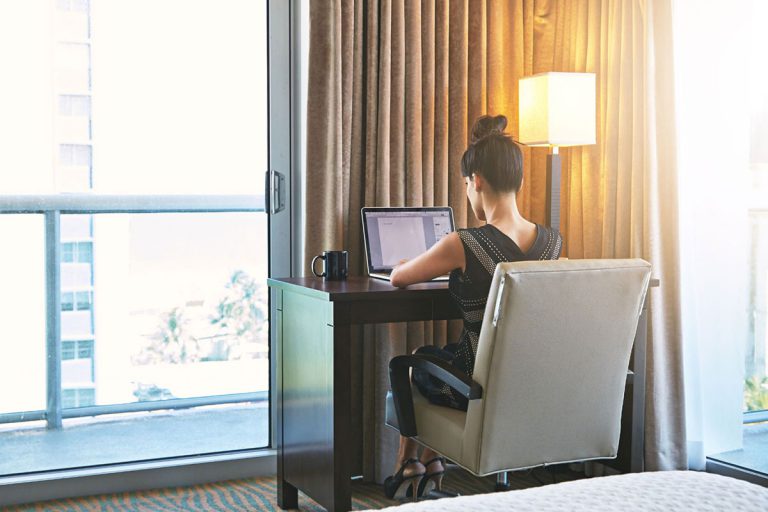Staying connected while traveling is important for business and leisure. Hotel WiFi offers a convenient way to get online, but first you need to pass the login page for secure access.
If you’re short on time, here’s a quick answer on how to access a hotel’s WiFi login page:
- When you first connect to the hotel’s wifi network, you should be automatically redirected to the login page. This usually happens when you open a web browser on your device.
- If you aren’t automatically redirected, try manually opening a web browser and navigating to any non-HTTPS website. The hotel network should detect this and redirect you to the login page.
- Some hotels require you to manually type in a specific URL in your browser to access the login page. This URL is usually printed somewhere in your hotel room or available at the front desk. It may be something like “wifi.marriott.com” or “login.hyattwifi.com”.
- As a last resort, you can try speaking to the front desk staff. Let them know you’re having trouble accessing the login page for the wifi, and ask if they can provide the specific URL or give you instructions.
- Once you get to the login page, enter the wifi credentials provided by the hotel. This is usually a username/password combination or a unique access code printed on a card in your room.
The key is just getting your browser redirected to that initial login page. The specific technique may vary by hotel, but one of these tips should allow you to access it.
In this comprehensive guide, we’ll explain why hotel WiFi uses splash pages, walk through the common ways to get to the portal, provide tips for troubleshooting login issues on different devices, and more.
Understanding Hotel WiFi Splash Pages
When you stay at a hotel, accessing the WiFi network is often a top priority. However, before you can start surfing the web, you will typically encounter a WiFi login page, also known as a splash page. These pages serve a specific purpose and understanding how they work can help you navigate them more efficiently.
Purpose of Hotel WiFi Login Pages
The main purpose of hotel WiFi login pages is to authenticate and authorize guests to access the hotel’s internet network. By requiring users to go through a login process, hotels can control and monitor the usage of their WiFi network. This serves as a security measure to protect the network from unauthorized access and ensures a better overall experience for all guests.
Hotel WiFi login pages often include terms and conditions that guests must agree to before gaining access. This helps protect the hotel from any misuse of the network and sets expectations for proper usage. Additionally, some hotels may use these login pages to display important information, such as local attractions, promotions, or announcements.
Types of Hotel WiFi Authentication
There are several different methods hotels use for WiFi authentication on their splash pages. Here are some common authentication types you may encounter:
- Open Network: This is an unsecured network. When you connect, you may be automatically redirected to a login or acceptance page (captive portal) where you need to accept terms and conditions to use the service.
- WEP/WPA/WPA2/WPA3: These are types of secured network protocols. WEP is the oldest and least secure, while WPA3 is the newest and most secure. In a hotel setting, you would typically be given a password to connect to the network.
- Captive Portal with Room Information: Some hotels require you to enter information, such as your last name and room number, on a captive portal page. Once this information is entered correctly, you’re allowed to access the internet.
- Captive Portal with Access Code: In this case, the hotel provides you with an access code (usually printed on a card or given at the front desk). You then enter this code on the captive portal page to gain access.
- MAC Address Authentication: Some hotels use MAC Address Authentication, where the hotel’s network recognizes a device by its MAC address. Once a device is recognized and approved, it can connect to the network. You might be asked to provide your device’s MAC address at check-in.
- Social Login: Some hotels might offer the option to log in using your social media credentials, such as Facebook, Twitter, or Google.
- Payment Portal: In some cases, particularly with more expensive or higher-end hotels or resorts, WiFi might be offered as a premium service. In these cases, you may need to go through a payment portal to purchase access to the network.
Remember, when connecting to public WiFi networks, you should always use a VPN to protect your data. Public networks can be insecure, and your data can be easily accessed by others.
It’s worth noting that hotel WiFi login pages can sometimes be a bit tricky to navigate, especially if you’re not familiar with the process. However, by understanding their purpose and the different authentication methods used, you can make the most out of your hotel WiFi experience.
Accessing the Hotel’s WiFi Login Page
When staying at a hotel, accessing the WiFi network is essential for many travelers. However, sometimes it can be a bit confusing to find the hotel’s WiFi login page. In this article, we will guide you through the process of accessing the hotel’s WiFi login page so that you can stay connected during your stay.
Connecting to the Wireless Network
The first step in accessing the hotel’s WiFi login page is to connect to the wireless network. Most hotels have a WiFi network available for guests, and it is usually indicated by a sign or mentioned during the check-in process. To connect to the network, simply go to your device’s settings, select the WiFi option, and choose the hotel’s network from the list of available networks. Once connected, you should see the WiFi symbol appear on your device’s screen.
Getting Redirected to the Login Page
After connecting to the hotel’s WiFi network, you may automatically get redirected to the WiFi login page. However, this is not always the case. If you don’t get redirected, try opening a web browser and navigating to a website. In most cases, you will be redirected to the login page. If not, try typing in the hotel’s website address or the IP address provided by the hotel in the address bar. This should take you to the login page.
Recommend: How To Force A Wifi Login Page: A Comprehensive Guide
Logging In or Accepting Terms of Service
Once you have accessed the hotel’s WiFi login page, you will be prompted to log in or accept the terms of service. Some hotels require you to enter a username and password provided by the hotel staff, while others may only ask you to accept the terms and conditions of using the WiFi network. If you are required to enter a username and password, it is usually provided on a card or given to you during the check-in process. If you are only asked to accept the terms of service, simply click on the “Accept” or “Agree” button to proceed.
It is important to note that every hotel may have a slightly different process for accessing their WiFi login page. If you encounter any difficulties, don’t hesitate to ask the hotel staff for assistance. They will be happy to help you get connected to the WiFi network.
Accessing Hotel WiFi on Different Devices
Laptops and Desktops
When it comes to accessing hotel WiFi on laptops and desktops, the process is usually straightforward. Upon connecting to the hotel’s WiFi network, you will often be redirected to a login page. This page may require you to enter a username and password provided by the hotel or may ask you to agree to the terms and conditions.
Once you have completed the necessary steps, you should be connected to the internet and able to browse the web. It is important to note that some hotels may have restrictions on the number of devices that can be connected to their WiFi network, so be sure to check with the front desk if you encounter any issues.
Also Read: Can Hotel Wifi See Private Browsing?
Smartphones and Tablets
Accessing hotel WiFi on smartphones and tablets is similar to the process on laptops and desktops. After connecting to the hotel’s WiFi network, you may be prompted to enter a password or agree to the terms and conditions. In some cases, the login page may not automatically appear, and you may need to open a web browser and navigate to a website to trigger it. Once you have successfully logged in, you can enjoy internet access on your device. It is worth mentioning that some hotels offer a separate WiFi network specifically for guests, which may require a different password or login process.
Gaming Devices and Media Streamers
Accessing hotel WiFi on gaming devices and media streamers can be a bit more challenging. These devices often have limited web browsing capabilities, which makes it difficult to access the login page. One workaround is to connect your device to a laptop or smartphone that is already logged in to the hotel’s WiFi network and share its internet connection.
Another option is to contact the hotel’s front desk and ask for assistance. Some hotels have separate networks or special instructions for gaming devices and media streamers, so it is always a good idea to inquire beforehand.
Also Read:
Troubleshooting Hotel WiFi Login Issues
When staying at a hotel, accessing the WiFi login page can sometimes be a frustrating experience. To help you overcome these issues, we have compiled a list of common problems and their solutions.
Dealing with No Automatic Redirect
One of the most common issues when trying to access a hotel’s WiFi login page is a lack of automatic redirect. This means that when you connect to the WiFi network, the login page does not automatically appear. In such cases, try opening your web browser and entering a common website address, such as www.google.com. If the login page still doesn’t appear, try clearing your browser cache and cookies. If the problem persists, contact the hotel’s front desk for assistance.
Bypassing Browser Popup Blockers
Another common issue is when your browser’s popup blocker prevents the WiFi login page from appearing. To bypass this, you can disable your browser’s popup blocker temporarily. In most browsers, you can do this by clicking on the browser’s settings or preferences menu and finding the option to disable popup blockers. Once disabled, try reconnecting to the WiFi network and the login page should appear. Don’t forget to re-enable the popup blocker afterwards to ensure your browsing experience is secure.
Changing Devices or Web Browsers
If you are still unable to access the WiFi login page, try switching to a different device or web browser. Sometimes, certain web browsers or devices may have compatibility issues with the hotel’s WiFi system. For example, if you are using Google Chrome, try switching to Mozilla Firefox or Internet Explorer.
Similarly, if you are using a smartphone, try using a laptop or tablet instead. This can help determine if the problem is specific to your device or browser.
Using Hotel Ethernet for Direct Login
If all else fails, you can try using the hotel’s Ethernet connection for a direct login. Most hotel rooms have an Ethernet port that allows you to connect your device directly to the internet. This bypasses any WiFi login pages and gives you immediate access. However, keep in mind that not all hotels may offer Ethernet connections in every room, so it’s best to check with the front desk beforehand.
Remember, troubleshooting hotel WiFi login issues may require some patience and experimentation. By following these steps, you can hopefully overcome any obstacles and enjoy a seamless internet experience during your stay.
Conclusion
Hotel WiFi splash pages and login portals are necessary to control access and prevent freeloaders. With the right approach, getting past the portal is quick and straightforward in most cases.
Understanding the reasons for hotel WiFi logins, following the automatic redirect process, and troubleshooting issues with your device or browser will keep you easily connected during your hotel stays.






